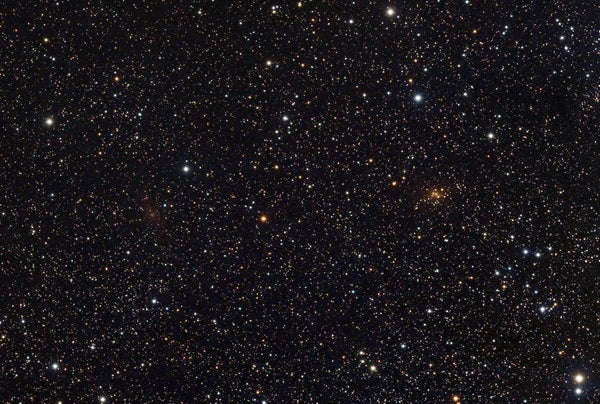Although galaxies appear throughout the sky, they are not spread evenly. They are found in small groups and larger clusters, and can be as close as the dwarf galaxies that orbit the Milky Way or as far away as the best telescopes can detect.
There is also a swath of sky where galaxies are few and far between. Pioneer galaxy observer Edwin Hubble called this the Zone of Avoidance. It is so named because the vast amount of stars, dust, and gas of the Milky Way’s plane overwhelm or block the feeble light of other galaxies.
But while these galaxies’ visible light is easily absorbed, their infrared light can penetrate the dust. Italian astronomer Paolo Maffei photographed the sky using a Schmidt camera with infrared-sensitive film in 1967. He found two fuzzy patches in Cassiopeia that became known as Maffei 1 and 2.
Astronomers think that, if not for its proximity to the galactic plane (about 0.5° away), Maffei 1 would be among the sky’s brightest galaxies. Dust has dimmed this E3-class elliptical by an estimated 4.7 magnitudes to magnitude 11.1, although its visible-light surface brightness — spread over 3.4′ by 1.7′ — is so low that it appears even fainter. In infrared light, however, the galaxy looks much larger. At an estimated distance of more than 9 million light-years, its long axis is about 75,000 light-years across.
You’ll find Maffei 1 slightly more than 4° north-northwest of Eta (η) Persei and 3° northeast of the Double Cluster in Perseus (see #54). But don’t be fooled by the galaxy’s bright apparent magnitude — Maffei 1 is challenging, requiring a large aperture and dark skies. It wasn’t until years after its discovery that this galaxy was pulled from obscurity, which is why it isn’t on many observing lists. Look for a faint glow superimposed with a sprinkling of faint foreground stars.
Maffei 1 is the brightest member of the nearest group behind the Local Group, along with Maffei 2 and IC 342 — the latter a large, open-face spiral with a low surface brightness in Camelopardalis.
Among the objects in this list, Maffei 1 is noteworthy in two ways: It is one of the most recently discovered targets and is among the most challenging to observe.
Make sure to explore Astronomy’s full list of 101 cosmic objects you must see. New entries will be added each week throughout 2022.
To get the latest astronomical news and observing content delivered directly to your door, subscribe to Astronomy magazine today!










